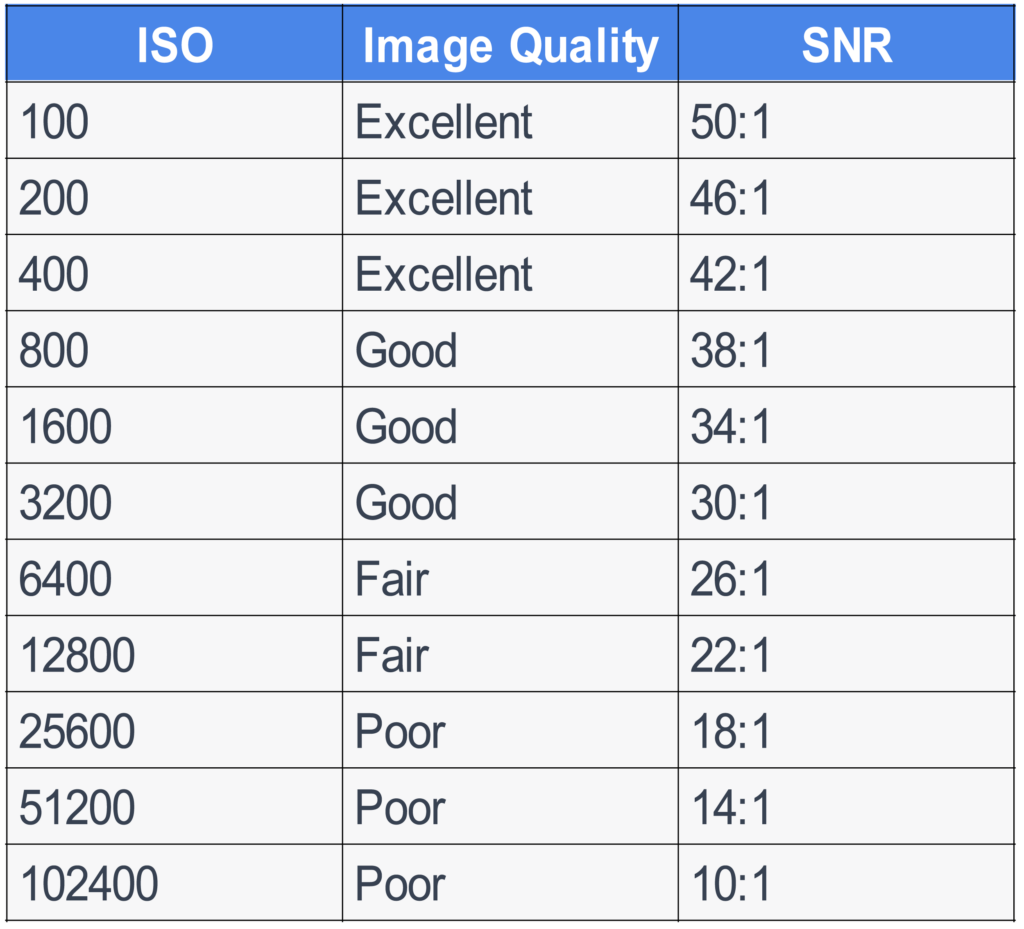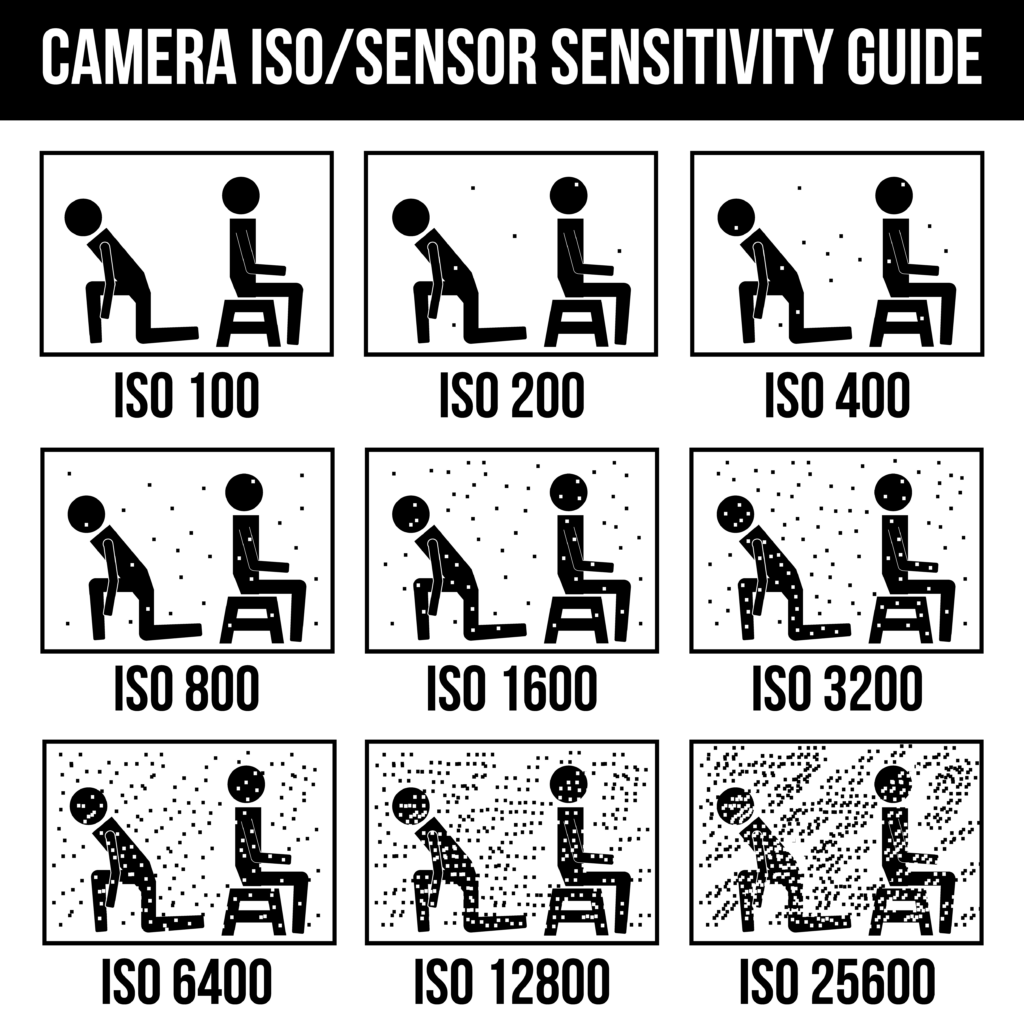Content Strategy

R1.5 Camera Settings: The Theory Behind ISO, Shutter & Aperture
Overview
In this module, we delve into the foundations of camera settings, specifically ISO, shutter speed, and aperture. We discuss ISO as a measure of light sensitivity, affecting the brightness and noise in images, with the concept of Dual Native ISO enabling better performance in varied lighting. We touch upon full-frame sensors’ advantages over crop sensors for superior ISO performance and dynamic range. Aperture is introduced as a crucial aspect controlling light entry, exposure, and depth of field, with larger apertures allowing faster shutter speeds and smaller ones aiding in flare control. Understanding these concepts is crucial to effectively manipulate camera settings for desired photographic results.
By The End of This Lesson Students Will Be Able To
- Understand that ISO stands for International Organization for Standardization and refers to the sensitivity of a camera’s sensor to light in photography.
- Recognize that the ISO setting in a camera adjusts the amplification of the electrical signals generated by the sensor as it captures an image, affecting its brightness.
- Appreciate that higher ISO settings enable photography in low-light conditions, but simultaneously increase the risk of introducing noise, or grainy patterns, into the image due to amplified unwanted signals.
- Comprehend that the signal-to-noise ratio (SNR) decreases as ISO increases, leading to a reduction in image quality.
- Understand the concept of Dual Native ISO, which allows for optimal image quality and noise performance in varying lighting conditions by switching between two base ISO settings.
- Identify that full-frame sensors, compared to crop sensors, provide better ISO performance and dynamic range due to their larger physical size and ability to gather more light.
- Understand that aperture refers to the opening in the camera lens, controlling the amount of light that reaches the sensor and influencing exposure and depth of field.
- Recognize that smaller f-stop numbers correspond to larger apertures, allowing more light in, while larger f-stop numbers signify smaller apertures and less light.
- Comprehend the advantages of fast lenses with large maximum apertures, including faster shutter speeds, better low-light performance, and the potential for a shallow depth of field.
- Appreciate the benefits of high-quality zoom lenses with a constant maximum aperture of f/2.8, offering consistent performance throughout the entire zoom range.
- Understand that smaller apertures can help control lens flare and create appealing effects with point light sources.
- Grasp the importance of finding the right balance between aperture size and exposure to achieve the desired photographic result.
Course Content

Camera Settings: The Theory Behind ISO, Shutter & Aperture
ISO, which stands for International Organization for Standardization, is a term used in photography to describe the sensitivity of a camera’s sensor to light. In the context of digital photography, ISO refers to the level of amplification applied to the electrical signals generated by the sensor as it captures an image. Essentially, increasing the ISO setting amplifies the signal produced by the sensor, making the image brighter, whereas decreasing the ISO setting reduces the amplification, resulting in a darker image.
The camera’s sensor is made up of millions of photosites or pixels, which are responsible for capturing light and converting it into an electrical signal. When the sensor is exposed to light, each photosite generates an electrical charge proportional to the amount of light it receives. This charge is then converted into a digital signal, which is processed and stored as image data.
As the ISO setting is increased, the camera applies more amplification to the electrical signal generated by the sensor. This increased sensitivity allows the camera to capture images in low-light conditions where a lower ISO setting would produce underexposed images. However, this increased sensitivity comes at a cost: the introduction of noise.
Noise in digital photography is the result of both the sensor’s inherent imperfections and the amplification process. When the ISO setting is increased, the camera amplifies not only the desired signal from the photosites but also any unwanted signals, such as electronic noise or thermal noise, which are present in the sensor. This results in random, grainy patterns or speckles in the image, particularly in the darker areas.
The reason for the introduction of noise as the ISO setting increases is due to the fact that the signal-to-noise ratio (SNR) decreases. SNR is the ratio of the desired signal (light information) to the unwanted noise. As the ISO setting is increased, the amplification of the electrical signal also amplifies the unwanted noise. This leads to a reduction in image quality, as the noise becomes more visible and starts to obscure image details.
ISO is an essential setting in digital photography that controls the sensitivity of the camera’s sensor to light. By adjusting the ISO, photographers can balance the exposure and image quality in various lighting conditions. However, increasing the ISO setting comes with the trade-off of introducing noise into the image, which can degrade the overall image quality. Understanding the relationship between ISO, light sensitivity, and noise is crucial for photographers to achieve the best possible results in their work.
Dual Native ISO is an advanced feature found in some modern digital cameras that provides two separate native ISO values, each with its own circuitry, for optimal image quality and noise performance. This technology allows photographers to switch between two base ISO settings, typically a lower and a higher value, depending on the lighting conditions. When shooting in well-lit environments, the camera can utilize the lower native ISO for minimal noise and optimal dynamic range. In low-light situations, the camera can switch to the higher native ISO, which allows for better noise performance without the need for excessive signal amplification. This results in cleaner images with less noise compared to traditional single native ISO cameras, particularly when shooting in challenging lighting conditions.
Full-frame sensors, as compared to crop sensors, generally offer better ISO performance and dynamic range due to their larger physical size. A full-frame sensor is equivalent in size to a 35mm film frame, whereas a crop sensor is smaller and has a crop factor that reduces the effective focal length of the lens. The larger photosites found in full-frame sensors can gather more light, which leads to a stronger signal and consequently, a higher signal-to-noise ratio. This translates into cleaner images with less noise, particularly at higher ISO settings.
In addition to better noise performance, full-frame sensors also tend to exhibit a wider dynamic range, which is the ability of a sensor to capture detail in both the darkest and brightest areas of an image. The larger photosites on a full-frame sensor can capture a greater range of light intensities, allowing for more detail to be retained in the highlights and shadows. This results in images with a richer tonal range and smoother gradations between different brightness levels. Consequently, full-frame cameras are often preferred by professional photographers for their superior image quality, especially in challenging lighting situations or when capturing scenes with a wide range of brightness levels.
Aperture is another fundamental aspect of photography that refers to the opening in the camera lens through which light enters and reaches the sensor or film. The size of the aperture is measured in f-stops (e.g., f/1.4, f/2.8, f/8) and plays a crucial role in controlling the exposure and depth of field in images. Smaller f-stop numbers correspond to larger aperture openings and allow more light to enter the camera, while larger f-stop numbers signify smaller apertures that let in less light.
A lens with a large maximum aperture (small f-stop number) is often referred to as a “fast” lens, as it can gather more light, allowing for faster shutter speeds and better low-light performance. Fast lenses are particularly popular among photographers for their ability to create a shallow depth of field, which can isolate the subject from the background and produce beautiful bokeh effects.
High-quality zoom lenses often feature a constant maximum aperture of f/2.8, which allows for consistent performance and light-gathering ability throughout the entire zoom range. This is advantageous for photographers who need to adapt quickly to various focal lengths while maintaining a constant exposure and depth of field.
Prime lenses, which have a fixed focal length, can offer even larger apertures, such as f/1.4 or f/1.2. These lenses are especially sought after for their ability to capture images in low-light conditions without sacrificing shutter speed or introducing excessive noise through high ISO settings.
When it comes to controlling flare and transforming large light sources into attractive point light sources, using a smaller aperture (larger f-stop number) can be beneficial. By reducing the aperture size, light enters the lens in a more controlled and precise manner, which can minimize lens flare and create pleasing effects with point light sources. However, it’s essential to find the right balance between aperture size and exposure to achieve the desired result.
In summary, understanding aperture and its relationship to photography is vital for controlling exposure and depth of field. Fast lenses with large maximum apertures offer numerous creative possibilities, and high-quality zoom lenses with a constant maximum aperture of f/2.8 provide versatility and consistent performance. Smaller apertures can be used to manage flare and create appealing point light source effects, but finding the right balance is crucial for achieving the desired outcome.

Cognitive Engagement Questions
- Assignment 1: Understanding ISO and Noise (Assignment #CAM-003)Objective: Comprehend the relationship between ISO, light sensitivity, and image noise.
Task: Students will need to take three different photographs of the same scene: one at a low ISO (e.g., 100), one at a mid-range ISO (e.g., 800), and one at a high ISO (e.g., 3200). Compare and analyze the image quality, brightness, and the level of noise present in each image. Write a report detailing their findings, focusing on how the ISO setting impacts the final image.
Email Subject: Assignment #CAM-003: Understanding ISO and Noise
Assignment 2: Exploring Dual Native ISO (Assignment #CAM-004)
Objective: Understand the concept of Dual Native ISO and how it impacts image quality and noise performance.
Task: Students with access to a camera that supports Dual Native ISO should take two photos of the same low-light scene: one using the lower base ISO, and one using the higher base ISO. Write a brief analysis comparing the image quality, noise levels, and overall performance between the two settings.
Email Subject: Assignment #CAM-004: Exploring Dual Native ISO
Assignment 3: Mastering Aperture and its Effects (Assignment #CAM-005)
Objective: Comprehend the influence of aperture on exposure, depth of field, and image effects.
Task: Students should take three photos of the same scene using different aperture settings (large, medium, and small). Analyze how these different settings affect image brightness, depth of field, and, if possible, the rendering of point light sources. Write a summary detailing their findings.
Email Subject: Assignment #CAM-005: Mastering Aperture and its Effects
© 2023 Karimah Clinton Academy. All rights reserved.
